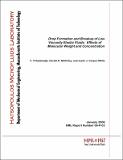Drop Formation and Breakup of Low Viscosity Elastic Fluids: Effects of Molecular Weight and Concentration
Author(s)
Tirtaatmadja, Viyada; McKinley, Gareth H.; Cooper-White, Justin J.
Download06-P-03.pdf (1.046Mb)
Metadata
Show full item recordAbstract
The dynamics of drop formation and pinch-off have been investigated for a series of low viscosity elastic fluids possessing similar shear viscosities, but differing substantially in elastic properties. On initial approach to the pinch region, the viscoelastic fluids all exhibit the same global necking behaviour that is observed for a Newtonian fluid of equivalent shear viscosity. For these low viscosity dilute polymer solutions, inertial and capillary forces form the dominant balance in this potential flow regime, with the viscous force being negligible. The approach to the pinch point, which corresponds to the point of rupture for a Newtonian fluid, is extremely rapid in such solutions, with the sudden increase in curvature producing very large extension rates at this location. In this region the polymer molecules are significantly extended, causing a localised increase in the elastic stresses, which grow to balance the capillary pressure. This prevents the necked fluid from breaking off, as would occur in the equivalent Newtonian fluid. Alternatively, a cylindrical filament forms in which elastic stresses and capillary pressure balance, and the radius decreases exponentially with time. A (0+1)-dimensional FENE dumbbell theory incorporating inertial, capillary and elastic stresses is able to capture the basic features of the experimental observations. Before the critical ‘pinch time’ tp , an inertial-capillary balance leads to the expected 2/3-power scaling of the minimum radius with time, Rmin ∼ (tp − t)^2/3. However, the diverging deformation rate results in large molecular deformations and rapid crossover to an elasto-capillary balance for times t > tp. In this region the filament radius decreases exponentially with time Rmin ~exp[(tp - t) / λ1], where λ1 is the characteristic time constant of the polymer
molecules. Measurements of the relaxation times of PEO solutions of varying concentrations and molecular weights obtained from high speed imaging of the rate of change of filament radius are significantly higher than the relaxation times estimated from Rouse-Zimm theory, even though the solutions are within the dilute concentration region as determined using intrinsic viscosity measurements. The effective relaxation times exhibit the expected scaling with molecular weight but with an additional dependence on the concentration of the polymer in solution. This is consistent with the expectation that the polymer molecules are in fact highly extended during the approach to the pinch region (i.e. prior to the elasto-capillary filament thinning regime) and subsequently as the filament is formed they are further
extended by filament stretching at a constant rate until full extension of the polymer coil is achieved. In this highly-extended state, inter-molecular interactions become significant producing relaxation times far above theoretical predictions for dilute polymer solutions under equilibrium conditions.
Description
Submitted to Phys. Fluids
Date issued
2007-01-23Series/Report no.
06-P-03
Keywords
PEO, Capillary thinning, drop breakup
Collections
The following license files are associated with this item: